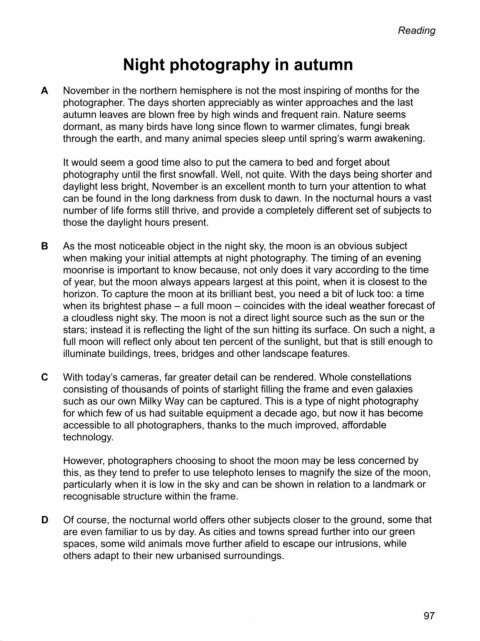Page 392 - Cam General 15-16-17-18-19
P. 392
Reading
Night photography in autumn
A November in the northern hemisphere is not the most inspiring of months fo「 the
photographer. The days shorten appreciably as winter approaches and the last
autumn leaves are blown free by high winds and frequent 「ain. Nature seems
dormant, as many birds have long since flown to warmer climates, fungi break
through the ea「th, and many animal species sleep until spring’S warm awakening.
It would seem a good time also to put the camera to bed and forget about
photography until the first snowfall. Well, not quite. With the days being sho「ter and
daylight less bright, November is an excellent month to turn your attention to what
can be found in the long darkness from dusk to dawn. In the nocturnal hours a vast
number of life forms still thrive, and provide a completely different set of subjects to
those the daylight hou「s present.
B As the most noticeable o同ect in the night sky, the moon is an obvious subject
when making your initial attempts at night photography. The timing of an evening
moonrise is important to know because, not only does it va「y according to the time
of year, but the moon always appears largest at this point, when it is closest to the
horizon. To capture the moon at its brilliant best, you need a bit of luck too: a time
when its brightest phase - a full moon - coincides with the ideal weather forecast of
a cloudless night sky. The moon is not a direct light source such as the sun or the
stars; instead it is reflecting the light of the sun hitting its surface. On such a night, a
full moon will reflect only about ten percent of the sunlight, but that is still enough to
illuminate buildings, trees, bridges and other landscape features.
C With today’s cameras, far greater detail can be rendered. Whole constellations
consisting of thousands of points of starlight filling the frame and even galaxies
such as our own Milky Way can be captured. This is a type of night photography
for which few of us had suitable equipment a decade ago, but now it has become
accessible to all photographers, thanks to the much improved, a忏ordable
technology.
However, photographers choosing to shoot the moon may be less concerned by
this, as they tend to prefer to use telephoto lenses to magnify the size of the moon,
pa「ticularly when it is low in the sky and can be shown in relation to a landmark or
recognisable structu「e within the frame.
D Of course, the nocturnal world offers other subjects closer to the ground, some that
are even familiar to us by day. As cities and towns spread further into our g「een
spaces, some wild animals move further afield to escape our intrusions, while
others adapt to their new urbanised surroundings.
97

